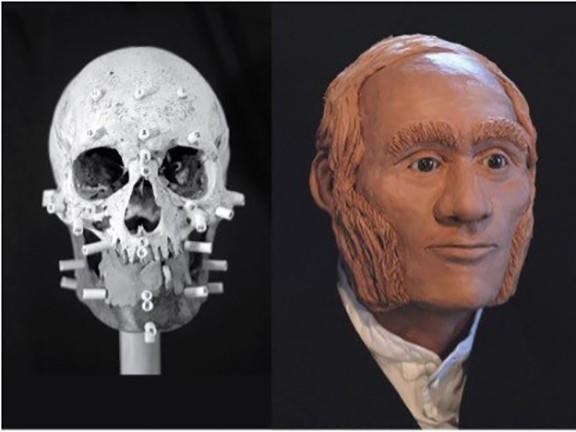Canadian archeologists have used DNA analysis to identify the remains of a Franklin expedition sailor and to link him with his modern-day descendants.
"The news came by email and I was at work," said Jonathan Gregory of Port Elizabeth, South Africa, the great-great-great-grandson of John Gregory, whose remains were found on King William Island in Nunavut.
"I literally needed to hold on to my seat when I was reading."
It's the first time genetics have been used to identify any of the 129 officers and crew on the expedition, which was lost in the Arctic in 1848 while searching for the Northwest Passage. The men's fate has given rise to one of the North's most enduring mysteries, now slightly less so.
"The real story lies in learning as much as we can about the men who perished on this expedition. This was an opportunity to do that," said Doug Stenton, a University of Waterloo archeologist who co-led the research.
Capt. John Franklin led an expedition out from England in 1845 to look for a sea lane to Asia over the top of North America. HMS Erebus, its sister ship HMS Terror and the officers and seamen aboard both never returned.
More than 30 expeditions tried to find them. A few artifacts, graves and horrible tales of cannibalism were all that was uncovered.
Three sailors were found in marked graves on Beechey Island and another three men were tentatively named through artifacts buried with them. Through a blend of Inuit oral history and high-tech surveys, the Erebus was found in 2014 and the Terror two years later.
But remains found at three sites on King William Island — about 100 kilometres from the ships — were never identified.
The 23 sailors died after having spent three years frozen in sea ice. They abandoned their ships and hauled Royal Navy lifeboats across the tundra on sledges in an attempt to escape.
In 2013, Stenton investigated one of the sites — an isolated cairn atop the partial skeletons of three men.
"I paused and just stopped and looked around and imagined," recalled Stenton, whose research is published in the journal Polar Record.
"These men were hauling heavily laden sledges with boats. Snow blindness, frozen fingertips ... It's pretty daunting trying to visualize what it was like."
Stenton and his colleagues have analyzed DNA from 27 of Franklin's crew.
That DNA was mentioned in a museum show after the excavation of the two ships. A sign posted in that show asked visitors with family links to the expedition to get in touch.
The Gregory family has long known about its Franklin connection.
"We've got lots of memorabilia," said Gregory, 38. "It was something we always knew of."
So when a relative of his in British Columbia heard about the request and passed it along, Gregory reached out. Once it seemed possible that there was a direct paternal connection, researchers sent him a DNA testing kit.
Eventually, the results came in. Gregory, who manages a retail outlet in Port Elizabeth, still remembers the shock of reading the message.
"'We are pleased to inform you it was a positive match,' (it said)."
"It was an incredible day for me and my family."
John Gregory wasn't even a sailor. Contemporary records show he was an engineer at the firm that made the steam engines in Franklin's ships. He went along to mind them as a newly minted warrant officer.
There are no pictures of John Gregory. The research team has constructed a bust of what he may have looked like.
"I definitely think it had a resemblance to my grandfather," said Gregory. "My mom is still alive and she's extremely proud."
John Gregory's remains were returned to the site in 2014 and placed in a new cairn.
His great-great-great-grandson said there's just one more thing he'd like to do — stand on the lonely, remote spot where his namesake ancestor suffered and died.
"I think that would be quite eerie," he said. "But I like to believe that closure would be a good word, that we've joined the dots."
More dots could be joined, Stenton said.
"We're always working on this. We're very interested in anyone else who is a descendant."
John Gregory himself was last heard from in a letter to his wife Hannah and their five children dated July 9, 1845, posted from Greenland. It closes:
"Give my kind Love to Edward, Fanny, James, William, and kiss baby for me — and accept the same yourself."
This report by The Canadian Press was first published May 4, 2021.
— Follow at @row1960 on Twitter
Bob Weber, The Canadian Press



